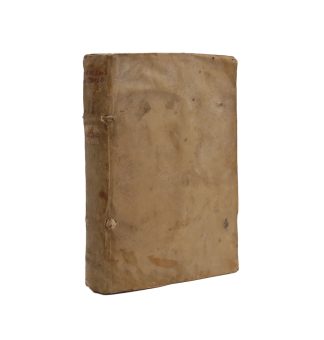FERRIER, Auger.
Des jugemens astronomiques sur les nativitez
Lyon, Benoît Rigaud, 1577£2,750.00
16mo. pp. 170 [iv]. A-L8. (without blank L8). Roman letter, some Italic. Two charming woodcuts of astrologers on title, small woodcut initials, typographical ornaments, armorial bookplate of A Brolemann on pastedown, early mss. shelf mark above. Light age yellowing, very minor light waterstain on last few leaves. lower outer corner of t-p restored. A very good copy, crisp and clean in contemporary limp vellum, remains of ties.
A lovely copy of this beautifully printed and rare astrological work, the first edition was printed in 1550, and frequently there after for over a hundred years; the work was translated to English in 1593. Ferrier was born in 1513 near Toulouse and studied medicine at Montpellier, perhaps overlapping with Francois Rabelais, before returning to practise in Toulouse in 1540. This work is a short and very practical work of pure astrology, in which, in clear and easily understandable terms, all aspects of the art of making and interpreting horoscopes are dealt with, mainly on the basis of the work of Arab astrologers. The work was particularly useful to those who wanted to learn the first rudiments of astrology without religious or philosophical interpretation.
“Another popular Renaissance work on natal astrology was Auger Ferrier’s ‘jugemens astronomiques sur les nativitez’ … Ferrier was a well-known physician and astrologer of Toulouse and wrote a number of books including a treatise on critical days ‘according to Pythagorean doctrine and astronomical observation’ (Thorndike VI p. 479) as well as a work on dream interpretation. Ferrier was personal physician and astrologer to Queen Catherine the Medici of France and a colleague of the famous Nostradamus. Catherine the Medici was fascinated with astrology and magic and ‘jugemens astronomiques sur les nativitez’ was dedicated to her… Ferrier’s (work) provides an excellent example of Renaissance natal technique which is still capable of accurate natal prediction and has the virtue of being much easier to learn than Bonatti’s mediaeval natal methods.” Christopher Warnock. ‘Ferrier’s Judgment of Nativities’.
“Now, Ferrier is without doubt one of those secondary figures of the intellectual world of Renaissance France, who is slowly attracting the attention of critics, not just for his medical treatises on syphilis, the plague, and general practice, but also (and perhaps even more so) for his astrological work, the ‘liber de diebus decretoriis’, and above all the ‘jugemens astronomiques sur les nativitez’ by which in the autumn of 1549 he apparently gained the favour of Catherine de Médicis, well before Nostradamus rose to fame. In effect, the influence of Ferrier’s astrological work not only spread to England and Spain, but stretched well into the 18th century, even though by that time the sun had moved, as it were, from its terrestrial orbit to the centre of the solar system. His medical writings were similarly translated, reprinted and anthologised, suggesting a longer lasting renown than Ferrier is usually given credit for, even if it is true that by the early 19th century, the medical establishment had become dismissive of his accomplishments.” Ingrid de Smet. ‘Of Doctors Dramers and Soothsayers; the interlinking world of Joseph Scaliger and Auger Ferrier.”
A very charming copy.
USTC 10086. Cantamessa 2581. Caillet II 3879. Brunet II 1235. Graesse II 573. Houzeau-Lancaster 4849 (first edn.). Dorbon 1617 (first edn.). Thorndike VI p. 479.In stock








